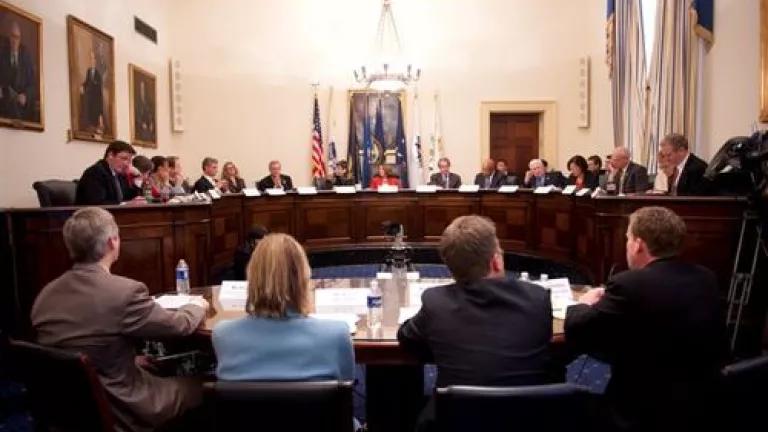
The House Democratic Steering and Policy Committee invited me to testify on Monday, and an impressive 15 Members of Congress participated in a wide-ranging discussion. The topic was our oil dependence in light of renewed volatility in the global marketplace thanks to unrest in the Middle East where 70 percent of the world's remaining reserves lie. Here's my testimony:
Oil is again at the $100-per-barrel mark, part of a wild and perilous roller coaster ride – since early 2007 prices rose from $50 a barrel to $150, back down to $40, and now right back up. Almost four decades after President Nixon called for an end to our oil dependence, we remain shackled to a global oil price market that is taking for this rough ride.
The simple truth is that we are addicted to oil. We consume 19.2 million barrels daily, enough to fill the Empire State Building three times over. And we are the oil-guzzling king, consuming more than 26 percent of the world’s production. On the other hand, we produce just 7.5 percent of the 73.5 million barrels produced globally every day. And we have a mere 1.6 percent of the world’s proven reserves, after decades of investment and more than a million wells drilled. The fact is that we’ve already “drilled baby drilled” more than any other nation on earth.
So who has the trump cards in the global oil game? The nations with the most proven reserves are: Saudi Arabia, Canada, Iran, Iraq, Kuwait, Venezuela, United Arab Emirates, Russia, Libya, and Nigeria.
These nations control more than 80 percent of reserves. And most are part of a cartel – the Organization of Petroleum Exporting Countries or OPEC – which controls 40 percent of the world’s production capacity. It’s these governments and a handful of others that control world oil supplies, not some invisible market hand. They rake in much of the one billion dollars we shovel abroad daily to pay for oil.
What about the big 5 oil companies? ExxonMobil is the largest with 11.7 billion barrels worldwide. Combined, private companies control about 10 percent. ExxonMobil, BP, Chevron, ConocoPhillips and Shell made profits from their position totaling nearly one trillion dollars between 2001 and 2010, according to the Center for American Progress.
These companies control a large share of U.S. refining capacity and retail distribution, allowing them to set wholesale prices for retailers, who add a modest charge on top of these prices. So when prices go up at the pump, small businesses see little of the benefit while Big Oil and OPEC profit handsomely.
Thankfully we’re beginning to drive down our oil dependence. The 2007 energy bill put us on the right road by enacting the first substantial increases in car and truck fuel economy in decades. The Supreme Court decision green-lighting EPA clean car rules in 2008 built on that victory. And the Obama Administration has raised the performance bar further.
But there’s a long way to go – we still import half of our oil, and half of that comes from OPEC. We can shield ourselves in part by shifting to pluggable cars. Putting millions of hybrid and all-electric cars on the road and increasing the fuel-efficiency of the rest of the fleet could boost the average to 60 miles per gallon by 2025 and save millions of barrels of oil daily.
Yet H.R. 1 would block implementation of the current National Program for new national pollution and fuel economy standards. Furthermore, it would block extending the success of the first round by defunding EPA work in this area, which partners with DOT on this program.
H.R. 1 would also slash funding for public transportation and rail projects. But consumers need fuel choices and they deserve more mobility choices. Increasing fuel-efficiency of our car and truck fleet will insulate our economy from price hikes by driving down oil-intensity. Consumers should also be able to switch energy sources and means of travel in response to price spikes.
Now is the time to exit this rickety, risky rollercoaster ride, by delivering more fuel-efficient vehicles as well as more energy and mobility choices to Americans. Let’s get to work.
